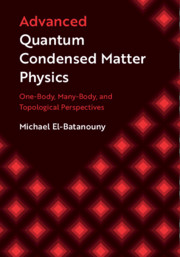Book contents
- Frontmatter
- Dedication
- Contents
- Preface
- Part One One-Electron Theory
- 1 Preliminaries
- 2 Electrons and Band Theory: Formalism in the One-Electron Approximation
- 3 Electrons and Band Theory: Methods of Energy-Band Calculations
- 4 Electrons and Band Theory: Effects of Spin–Orbit Interactions
- 5 Linear Response and the Dielectric Function
- 6 Phonons and Lattice Dynamics
- 7 Dimensionality, Susceptibility, and Instabilities
- Part Two Topological Phases
- Part Three Many-Body Physics
- References
- Index
4 - Electrons and Band Theory: Effects of Spin–Orbit Interactions
from Part One - One-Electron Theory
Published online by Cambridge University Press: 06 March 2020
- Frontmatter
- Dedication
- Contents
- Preface
- Part One One-Electron Theory
- 1 Preliminaries
- 2 Electrons and Band Theory: Formalism in the One-Electron Approximation
- 3 Electrons and Band Theory: Methods of Energy-Band Calculations
- 4 Electrons and Band Theory: Effects of Spin–Orbit Interactions
- 5 Linear Response and the Dielectric Function
- 6 Phonons and Lattice Dynamics
- 7 Dimensionality, Susceptibility, and Instabilities
- Part Two Topological Phases
- Part Three Many-Body Physics
- References
- Index
Summary
Derives the spin–orbit interaction from the Dirac equation and discusses its manifestations in electronic structure using the k · p method. The Dresselhaus and Rashba Hamiltonians are developed.
- Type
- Chapter
- Information
- Advanced Quantum Condensed Matter PhysicsOne-Body, Many-Body, and Topological Perspectives, pp. 115 - 145Publisher: Cambridge University PressPrint publication year: 2020

